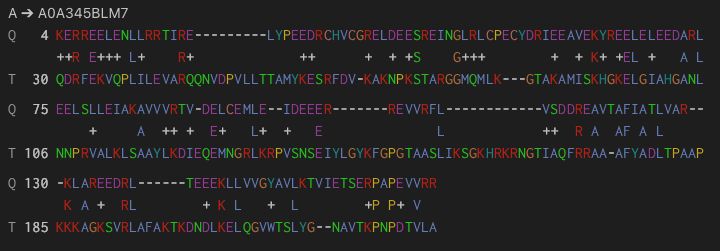lover of molecules, user of computers
https://scholar.google.com/citations?user=63ZRebIAAAAJ&hl=en


colabfold pLDDT is high, but there's big disagreement on the N terminus there. against the foldseek hit, also no alignment on the N-terminus.


colabfold pLDDT is high, but there's big disagreement on the N terminus there. against the foldseek hit, also no alignment on the N-terminus.
this is a 200-mer inferred with unconditional generation using their baseline v1.1 model. la-proteina structure in blue. L: alignment with colabfold inference. R: partial alignment w foldseek hit (rmsd 8.2A)
research.nvidia.com/labs/genair/...


this is a 200-mer inferred with unconditional generation using their baseline v1.1 model. la-proteina structure in blue. L: alignment with colabfold inference. R: partial alignment w foldseek hit (rmsd 8.2A)
research.nvidia.com/labs/genair/...
here is a solution of gelatin. purchased from Sigma, resuspended in PBS, under blue LED illumination.
🤨 idk #WhatsTheMechanism

here is a solution of gelatin. purchased from Sigma, resuspended in PBS, under blue LED illumination.
🤨 idk #WhatsTheMechanism

"this book is like the Bible, but you'll learn a lot more about Life"

"this book is like the Bible, but you'll learn a lot more about Life"




or is it a real Swedish word/backcronym?
and i can't tell if google is having a stroke or just fucking with me



or is it a real Swedish word/backcronym?
and i can't tell if google is having a stroke or just fucking with me

SPCs have a thin hydrogel shell surrounding a liquid core. they're miniature reaction vessels that can trap cells and large molecules while allowing nutrient, waste, and reagents exchange 🧪🧵

SPCs have a thin hydrogel shell surrounding a liquid core. they're miniature reaction vessels that can trap cells and large molecules while allowing nutrient, waste, and reagents exchange 🧪🧵





their table has reads per cell but not UMIs per cell, which IMO is an important comparison that is left out. further rarefaction analysis is warranted

their table has reads per cell but not UMIs per cell, which IMO is an important comparison that is left out. further rarefaction analysis is warranted


if i understand correctly, the bottom reconstruction should look a lot like the top image, and to me it really doesn't! so, did it work?

if i understand correctly, the bottom reconstruction should look a lot like the top image, and to me it really doesn't! so, did it work?
photo credit: Google Maps

photo credit: Google Maps





